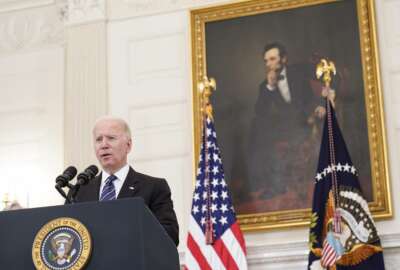OPM to create Chief Diversity Officer Council to elevate role across government
OPM is creating a Chief Diversity Officer Council and exploring the possibility of creating a job classification series for federal employees who work as divers...
The Office of Personnel Management is calling on agencies to name a chief diversity officer who reports to their senior leadership if they haven’t already done so.
To accelerate progress on this goal, OPM is creating a Chief Diversity Officer Council and exploring the possibility of creating a job classification series for federal employees who work as diversity experts.
Rita Sampson, the director of OPM’s Office of Diversity, Equity, Inclusion and Accessibility, said the steering committee responsible for standing up the council will hold its first meeting next Tuesday and will meet weekly for the near future.
OPM made the announcement after it issued a memo to agencies last week with guidance on how to effectively create a chief diversity officer (CDO) or diversity and inclusion officer (DIO) position.
Agencies, meanwhile, are expected to finalize their strategic plans for diversity, equity, inclusion and accessibility by March 23, under the executive order President Joe Biden signed last year.
“For too long, we have organizations working in silos. One does not know what the other organization is doing, and therefore, the opportunity to really make a difference is minimized, because people are not working together in tandem,” Sampson said Tuesday in a webinar about reimagining the role of agency chief diversity officers.
Aside from bringing together chief diversity officers across government, Sampson said meeting the goals of the administration’s executive order will require coordination from agency equal employment opportunity personnel, human capital officials and chief data officers.
“Anyone who influences the outcome of DEIA needs to be at the table and communicating and collaborating with each other,” she said.
OPM stood up a Diversity and Inclusion in Government Council in 2015, under an executive order signed by former President Barack Obama, but Sampson said the organization disbanded years ago.
Kimberly Holden, the deputy associate director for employee services, said OPM plans to start exploring the need for an occupational series on diversity work around the start of fiscal 2023.
If OPM decides to move ahead with creating a new job series, the process will likely take years to complete. The agency released its new occupational series for data scientists in government in December, after starting the project in 2019.
In the meantime, OPM said agencies can classify chief diversity officers through a variety of existing job series, including those tied to human resources, EEO and miscellaneous administration officials.
OPM Director Kiran Ahuja, in last week’s memo, urged agencies to hire chief diversity officers “as soon as practicable,” make sure they report to the secretary of their agencies, and are empowered to promote collaboration across the organization.
“Senior officials play an essential role in establishing strategic priorities and closing opportunity gaps. A CDO or DIO can play an instrumental role in closing DEIA opportunity gaps that have been identified through internal deliberative processes, external oversight findings, and promising practices,” Ahuja wrote.
OPM said agencies who decide to establish a CDO or DIO position should ensure they have the necessary resources, and “phase in long-term budget and staffing processes to ensure the sustainability of these critical leadership roles.”
Aside from making the federal government more representative of the country’s population, agencies see a commitment to DEIA principles as a necessary element of meeting their mission.
Robert Hogue, the Navy’s acting assistant secretary and principal deputy assistant secretary for manpower and reserve affairs, said the success of the Marine Corps’ female engagement teams serving on the front lines in Afghanistan led to the Defense Department opening all military occupations and positions to women in 2016.
Hogue said these female engagement teams excelled at gathering intelligence from Afghan women not accustomed to speaking with men outside of their families.
“What we found is when we started to put women on the battlefield, that suddenly we opened up an intelligence source that had been previously denied to us, and double the amount of intelligence that came into our operating unit to make them that much more effective,” Hogue said.
Hogue said that case study became a watershed moment for the Navy, which is looking at the ways in which other historically underrepresented demographics might address some of its biggest challenges.
The Navy, he added, is building a model using data from the Bureau of Labor Statistics and the Census Bureau to show where it has underrepresented demographics in its offices and military occupational specialties.
“It’s very clear that our view on gender was just wrong, and so we’re now really reevaluating that business case and trying to figure out how to harness that energy and those different perspectives going forward. I think we’re going to find other areas where under-representation will teach us similar lessons,” he said.
The Army is making a similar case for making DEIA part of its readiness goal. The military branch last year stood up a Diversity, Equity and Inclusion Council, chaired by the secretary of the Army.
Anselm Beach, the Army’s deputy assistant secretary for equity and inclusion, said the service so far has held listening sessions at 27 installations and gathered feedback from nearly 9,000 personnel.
Beach said agencies can’t simply “hire their way into diversity” by recruiting from underrepresented groups. Instead, he said agencies need to create an environment where those new hires see a path for promotion.
“It’s not just about going down to HBCUs and saying, ‘Hey, we are underrepresented, come to us,’” Beach said, “People want a job, you attract them, you select them, but they attrit, because there is not the framework that they feel that sense of belonging.”
Kia Scipio, the director of diversity, equity and inclusion at the law firm Ropes & Gray, said it may be hard for leadership at agencies and organizations with an established workplace culture to see DEIA principles as important to the workplace mission, especially if they think the organization is already running well.
“There are systems and processes that may be inequitable and prevent people from fully maximizing their potential. And that is a really hard concept for people to wrap their heads around, especially when they see that everything seems to be working well, and they see these sorts of issues or people that are affected as almost outliers,” Scipio said.
Beach said an effective chief diversity officer needs to be a “student of organizations,” and make sure every employee is able to work to their full potential.
“Diversity is not a number. It’s about knowing who your people are. It’s about what makes them tick. How do they show up, are they introverted or extroverted? What is their approach to work, and knowing them in terms of what value they bring to the organization?”
Natalie Holder, the chief diversity, equity, and inclusion officer at Stanford’s SLAC Accelerator, an Energy Department-owned and managed laboratory, previously served as the chief diversity officer for Capitol Police.
In that role, she helped the force improve recruitment and retention for a generation of officers by recruiting women college athletes. At one point, Holder said this effort led to a 25% quarterly increase in the recruitment of women officers.
For DEIA principles to have a lasting effect in the federal workforce, Holder said agency leaders need to see them as an essential part of their work.
“I don’t believe that this work is all about doing the right thing. I believe that if it’s going to be sustainable, if it’s going to be something that outlives budget cuts, if it’s going to be something that is a part of how the organization sees itself, being able to even operate, it has to be a part of the business goals of the organization,” Holder said.
Copyright © 2024 Federal News Network. All rights reserved. This website is not intended for users located within the European Economic Area.
Jory Heckman is a reporter at Federal News Network covering U.S. Postal Service, IRS, big data and technology issues.
Follow @jheckmanWFED






